Part 6 of WIDA’s Essential Action Series. Click here to return to the first article in the series.
In WIDA’s Essential Actions: A Handbook for Implementing WIDA’s Framework for English Language Development Standards, Gottlieb (2013) explains how to integrate WIDA’s language standards with Common Core State Standards. She writes:
The blending of content and language standards is integral to the achievement of ELLs. The content standards, including the Common Core State Standards and Next Generation Science Standards, provide the necessary grade-level concepts and skills while the language development standards offer examples of the associated language critical for understanding the content. Content standards, in conjunction with language development standards, enable teachers to design curriculum, craft instruction, and plan classroom assessment for ELLs. Both language and content standards recognize academic language as essential to learning; however, it is the language development standards that provide for differentiation based on students’ levels of language proficiency (p.37).
Gottlieb recently published a book entitled Assessing English Language Learners: Bridges from Language Proficiency to Academic Language.
I will borrow this principle and explain how I connected the International Baccalaureate Middle Years Program Language Acquisition Standards to the ones found in an Individuals and Society (history) course. Regardless of the standards that you use, I hope that these case studies provide an example of how you can integrate content and language standards together to create a meaningful learning experience for ELs
Research Suggests
The role of content standards is to provide the concepts and skills necessary for grade-level performance. Language standards offer the skills required to process and produce content. Integrating content and language standards promotes collaboration among teachers (Morita-Mullaney, 2007; Echevarria, Vogt, & Short, 2008), which has shown to significantly enhance students’ achievement (Hattie, 2012). Academic language is developed when instruction is guided by both content and language standards because the content provides a context to use the language skills.
Do you ever get students who ask you, “When will we use this in the “real world?” Planning with content and language standards help students see how the skills they are learning in one class can be connected to other disciplines. But it’s about more than just being successful in other classes. It’s about developing transferable skills so that students can solve problems and successfully engage in authentic experiences.
CASE STUDY 1: Grade 7 Science
As I worked with Mr. A, a 7th grade science teacher to design a science unit on forces, we paid careful attention to intentionally integrating the science and English standards.

The three science standards expected students to design an investigation. The unit was about forces, so students were required to design an experiment that tested a hypothesis about force. For example, students created a paper helicopter. Some students changed the length of the wings while others altered the material of the helicopter to see how that would impact the flight time.
After conducting the experiment, students had to write a lab report to share their findings. Here is an image of Leaf (yes, I have a student named Leaf) dropping his helicopter from the second floor of the Secondary building to test his hypothesis.

In both English and science class, we focused on the language standard of organizing information and using cohesive devices. To begin with, I taught them procedural language such as “first, then, after that, finally” because they needed it to describe the steps of their experiment in the “method” section.
We also deconstructed the parts of the lab report (research question, hypothesis, raw data, data analysis, conclusion) using a process called Split Screen. Students explored which of these elements of the lab report would be appropriate at the beginning, which ones were best suited for the middle, and which one was best placed at the end of the lab report. This allowed them to develop the skill of organization using very specific language and phrases.
This unit also empowered students to develop writing skills and exemplified in-context instruction of language and content. They learned how to use specific cohesive devices, which they can use in other situations. They also practiced communicating in an academic register: the language of science.
Case Study 2: History
The next example comes from my collaboration with Mr. G and Mr. D, two 7th grade history teachers. This unit was about the concept of “systems”. Garrett and Duncan decided to have students explore religion as a form of a system.

As Mr. A and I planned, we saw a wonderful opportunity to have students present information to one another. Understanding is constructed through dialogue, so I structured the learning through a jigsaw. The phases are broken down below:
This particular case study demonstrates how we combined history content with language standards. It was not only a meaningful approach for acquiring content, but also an effective method for developing communication skills. Bedi (2016) suggests that prepared speech shares the same register as formal, academic written language. By having students do mini-informal presentations, ee raised the informal register to a more formal one and used talk as a form of performance and draft writing.
When the ELs were asked later to write an essay that compared religions, they had gained some familiarity with using formal language because they first practiced it during the mini-presentations. As language changes form depending on the content, task, and audience, we can design tasks – like mini-presentations – that gradually increase ELs’ use of formal language.
Applying Case Studies
These are the guiding questions that I use when thinking about ways to connect content and language standards together. There are two pathways to doing so: either starting from the content or starting from the language standards.
Once the content standards are identified:
- What social experiences, written, visual, or oral texts will be used to teach the content?
- What processing skills (reading viewing) will facilitate comprehension?
- What production (writing and speaking) skills facilitate creation using content knowledge?
Once the language standards are identified:
- What language standards are being assessed?
- What concepts can stimulate engagement with these standards?
- What topics are connected to this concept?
- What topic has a wealth of written, visual, and oral texts to process?
Reflection
Both of these case studies demonstrate how we connected content and language standards together to deliver meaningful instruction. Through this process, we are explicitly valuing both content knowledge and language skills. Additionally, this kind of planning naturally builds in opportunities for the language specialist to scaffold content and guide the ELs’ accurate communication of content knowledge and conceptual understanding.
The ELs did not feel like they were “learning language” directly while they were in Mr. G and Mr. D’s classes because the language skills were taught in the context of the history content. When we design in-context learning experiences, ELs move from simply “understanding” skills and knowledge to “owning” and “creating” with content and skills. The content provides a context to learn language; language becomes the means to learn content.
At the very least, I hope this style of planning inspires you to find ways to connect with other teachers from other disciplines to create contextualized learning experiences. My belief is that the next phase of learning will be a shift away from teaching silos, which are part of my generation’s educational experience, to a more interdisciplinary form of learning.
Next Post
Next week’s post will highlight WIDA’s Action 7, which is focused on designing lessons that have a sociocultural context. It follows along our theme of creating a context from which to learn language. I’ll share examples from different classes and content areas to demonstrate how I applied this principle into practice.
References
Bedi, I. (2016). Scaffolding Writing Across the Curriculum: An EAL Approach. Penarth, UK: Dragonfly EAL.
Echevarria, J., Vogt, M. E., & Short, D. J. (2008). Making content comprehensible for English learners: e SIOP® model (3rd ed.). Boston: Allyn and Bacon.
Hattie, J. (2012). Visible Learning for Teachers: Maximizing Impact on Learning. London: Routledge.
Gottlieb, M. (2013). Essential Actions: A Handbook for Implementing WIDA’s Framework for English Language Development Standards. Madison: Board of Regents of the U of Wisconsin System.
International Baccalaureate Program (2014a). Middle years programme language acquisition guide. Cardiff: International Baccalaureate Program.
International Baccalaureate Program (2014b). Middle years programme science guide. Cardiff: International Baccalaureate Program.
International Baccalaureate Program (2014c). Middle years programme humanities guide. Cardiff: International Baccalaureate Program.
Morita-Mullaney, T. (2007). Collaboration in assessment: Secondary and ESL teachers teaming together. In F. Pawan, & G. B. Sietman (Eds.), Helping English language learners succeed in middle and high schools (pp. 85–101). Alexandria, VA: Teacher of English to Speakers of Other Languages.



